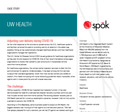Case studies
UW Health
Overview
UW Health is the integrated Health System of the University of Wisconsin-Madison. More than 650,000 patients from the Upper Midwest are served annually by 1,750 physicians and 21,000 staff at seven hospitals and 87 outpatient clinics. UW Health is consistently recognized as Wisconsin’s #1 hospital by U.S. News & World Report. UW Health is governed by the UW Hospitals and Clinics Authority and partners with UW School of Medicine and Public Health to fulfill their patient care, research, education, and community service missions.
Industry
- Healthcare
Business drivers
- Establish remote operator workstations
Solution
- Spok® operator console
Results
- Reports show operators are just as efficient at home as they are on-site
- Remote operator workstations are incorporated as part of disaster recovery and business continuity planning
- Transitioning Spok contact center software onto laptops proved a seamless and quick process
Adjusting care delivery during COVID-19
As the initial response to the coronavirus spread across the U.S., healthcare systems and facilities remained focused on providing care for all patients in the safest way possible. Doing so has systematically changed healthcare delivery and how healthcare organizations manage their operations.
The U.S. Center for Disease Control (CDC) issued guidance for healthcare organizations as they plan for and respond to COVID-19. One of their recommendations encourages organizations to review their pandemic plan and ensure it incorporates remote work-from-home policies.
For healthcare organizations, the contact center (operator services) is often the first point-of-contact for patients. Understandably, it has been among the first services to adjust their standard approaches. Given that most contact centers are staffed on location, this makes complying with social distancing guidelines nearly impossible, since agents work in close proximity and with shared resources.
The challenge
Without question, COVID-19 has impacted how hospitals function. It has also demonstrated the need for a well-planned disaster recovery business continuity plan that includes remote work-from-home policies. The existing disaster recovery plan at UW Health planned for numerous catastrophic scenarios, however it did not fully outline a pandemic scenario like COVID-19.
According to Chris Beardsley, senior business systems analyst at UW Health, the biggest obstacle was moving all of their agents to a remote-work posture. “We had five laptops prepared for such a scenario, yet we had 27 agents we needed working at home.”
Beardsley faced another challenge; most of their operators had never worked remotely and there was a perception that remote agents would be less productive. “Most of our operators have never worked from home, so we needed to help them get connected using our corporate VPN solution and their home WiFi,” explained Beardsley.
After several weeks, Beardsley admitted people still had differing opinions about remote agents. “Some think we should have done it a long time ago, and others are worried it opens the door for less-than-honorable work ethics. In the past, reporting tools were used primarily for evaluations and training. Now, we needed to ensure we could gauge productivity and prove whether people were performing their jobs effectively while working from home,” said Beardsley.
The solution
During the early stages of the pandemic, Spok offered its customers remote console workstation licenses to support work-from-home initiatives related to COVID-19 (at no charge during the COVID-19 crisis).
Beardsley and the team at UW Health worked internally to get Spok contact center solutions on all 27 laptops. According to Beardsley, moving all their agents to remote work took approximately one week to become fully operational and to reconfigure at-home workstations.
“The beauty of Spok remote console workstation software is that it’s a simple process and easy to set up,” explains Beardsley. “The software functions the same as it does for the on-site application.”
In fact, according to Beardsley, the biggest change for workers who rarely, if ever, have worked from home was modifying the phone information and establishing at-home internet access and VPN.
Our reporting has shown no drop or difference in talk time or speed of answer— operators are truly just as efficient at home.
– Chris Beardsley, Senior Business Systems Analyst, UW Health
The result
Beardsley’s advice to other hospitals is to establish at-home operator workstations before they’re needed. “From a disaster recovery and business continuity perspective, it’s wise to have remote operator workstations in place.” Hospitals can use their systems, technology, and the tools already available to them.
At UW Health, remote at-home operators have proven just as efficient as when operators are on-site. “The numbers don’t lie,” explains Beardsley. “Our reporting has shown no drop or difference in talk time or speed of answer—operators are truly just as efficient at home.”
With Spok contact center solutions in place, UW Health operators were able to maintain operations at the virtual frontline of the COVID-19 pandemic. Their efficiency meant they were ready to triage patient calls and ensure patient satisfaction.




